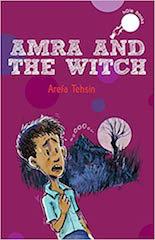

Amra was in trouble. Big trouble. As, in the popular adage, “Whatever can go wrong, will go wrong." Well, that was exactly what Amra’s day was like. First, the sole of his slipper came off, then he broke a jar of flour at home, then he reached late to school, then he had to to forgo his mid-day meal, then to cap it all, the mother of all troubles; a stone that he hurled to shoo away a porcupine that had strayed near the teacher, hit his very bald head instead. And then…the very frightened Amra took flight.
Now what should he do? He was trapped between the devil and the deep blue sea. Between a very angry teacher and possibly an equally angry mother at home. Desperate situations called for desperate solutions and so Amra decided to visit the most fearful and ferocious real-live village witch, Jeevti Dakkan, to seek her help.
We all tend to make mountains out of molehills and our problems seem to loom larger than life. Often one hears about children running away from home for fear of punishment and even worse, physically harming themselves. Hence, this story should comfort many a child that things do go wrong in everyone’s life, and that most situations are never as bad as they seem and, equally so, not all demons are as scary as they are made out to be, whether they exist in real life or in our imagination. A lot of food for thought served up with a touch of humour by the versatile and talented writer, Arefa Tehsin.
Besides, the story, Tehsin has gone the extra mile to blend in the flavour of the village with references to the fragrant flowers of raat-ki-rani, the fav local food--makki-ki-roti and curry made from the fruit of the mahua tree, as well as, the the odhni and ghagra worn by the mother and the local nomenclature for mother and father, namely, Bai and Ba.
The illustrations, too, need a special mention. By means of a few deft strokes of the pen, Chetan Sharma transports us into a typical Indian village. We see a boy spinning a tyre with a stick in the corn field, children seated in the open air classroom under a banyan tree, the simple interiors of the hut, the kerosene lantern dangling from the roof, the mother feeding her family in the kitchen cum dining cum living cum bed-room. This could open up the door for interesting discussions in a classroom on life in a village versus urban lifestyles.
All in all, another wHole-ly satisfying Hole book by Duckbill!